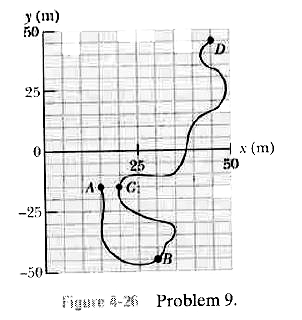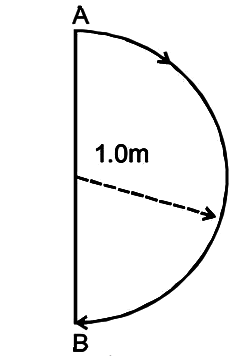Figure 4-26 gives the path of a squirrel moving about on level ground, from point A (at time t = 0), to points B (at t = 5.00 min), C (at t = 10.0 min), and finally D (at t = 15.0 min). Consider the average velocities of the squirrel from point A to each of the other three points. Of them, what are the (a) magnitude and (b) angle of the one with the least magnitude and the ( c) magnitude and (d) angle of the one with the greatest magnitude?

(a) 0.0083 m/s, (b) 0∘ (measured counterclockwise from the +x axis), ( c) 0.11 m/s, (d) 297∘ (counterclockwise from +x) or −63∘ (which is equivalent to measuring 63∘ clockwise from the +x axis).
Topper's Solved these Questions
- MOTION IN TWO AND THREE DIMENSIONSBOOK - RESNICK AND HALLIDAYCHAPTER - MOTION IN TWO AND THREE DIMENSIONSEXERCISE - PRACTICE QUESTIONS (SINGLE CORRECT CHOICE TYPE)
49 Videos
- MOTION IN TWO AND THREE DIMENSIONSBOOK - RESNICK AND HALLIDAYCHAPTER - MOTION IN TWO AND THREE DIMENSIONSEXERCISE - PRACTICE QUESTIONS (MORE THAN ONE CORRECT CHOICE TYPE)
3 Videos
- MOTION IN TWO AND THREE DIMENSIONSBOOK - RESNICK AND HALLIDAYCHAPTER - MOTION IN TWO AND THREE DIMENSIONSEXERCISE - CHECKPOINT
3 Videos
- MOTION ALONG A STRAIGHT LINEBOOK - RESNICK AND HALLIDAYCHAPTER - MOTION ALONG A STRAIGHT LINEEXERCISE - PRACTICE QUESTIONS ( Integer Type )
3 Videos
- OSCILLATIONSBOOK - RESNICK AND HALLIDAYCHAPTER - OSCILLATIONSEXERCISE - Practice Questions
57 Videos
Similar Questions
A train at a constant 60.0 km/h moves east for 40.0 min, then in a direction 50.0∘ east of due north for 20.0 min, and then west for 50.0 min. What are the (a) magnitude and (b) angle of its average velocity during this trip?
View SolutionIn 1.0 s, a particle goes from point A to point B, moving in a semicircle of radius 1.0 m. The magnitude of the average velocity is :-
View Solution
Knowledge Check
In 1.0s, a particle goes from point A to point B , moving in a semicircle of radius 1.0m (see figure ). The magnitude of the average velocity
 A3.14m/sB2.0m/sC1.0m/sDZero
A3.14m/sB2.0m/sC1.0m/sDZeroA particle is projected at time t=0 from a point P on the ground with a speed v0, at an angle of 45∘ to the horizontal. Find the magnitude and direction of the angular momentum of the particle about P at tiem t=v0/g
Aa. mv302√2gBb. mv30√2gCc. 3mv30√2gDd. √2mv30gA ground to ground projectile is at point A at t=T3, is at point B at t=5T6 and reaches the ground at t=T. The difference in heights between points A and B is
AgT26BgT212CgT218DgT224
In 1.0s, a particle goes from point A to point B , moving in a semicircle of radius 1.0m (see figure ). The magnitude of the average velocity

View SolutionIn 1.0s, a particle goes from point A to point B , moving in a semicircle of radius 1.0m (see figure ). The magnitude of the average velocity

View SolutionA particle is projected at time t=0 from a point P on the ground with a speed v0, at an angle of 45∘ to the horizontal. Find the magnitude and direction of the angular momentum of the particle about P at tiem t=v0/g
View SolutionLet A, B and C be points in a vertical line at height h, 4h5andh5 and from the ground. A particle released from rest from the point A reaches the ground in time T. The time taken by the particle to go from B to C is TBC . Then T(TBC)2=
View SolutionA point moves in the straight line during the time t=0 to t=3 according to the law s=15t−2t2. The average velocity is
View Solution
